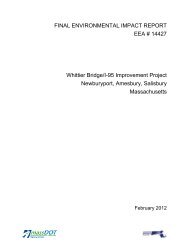Herbicide Alternatives Research - Executive Office of Transportation
Herbicide Alternatives Research - Executive Office of Transportation
Herbicide Alternatives Research - Executive Office of Transportation
Create successful ePaper yourself
Turn your PDF publications into a flip-book with our unique Google optimized e-Paper software.
Vermont has tested the use <strong>of</strong> allelopathic plants at selected sites (Personal communication with<br />
Craig Dusablon, Landscape Coordinator, Vermont Agency <strong>of</strong> <strong>Transportation</strong>). The plants<br />
selected were cultivars <strong>of</strong> sheep fescue (Festuca ovina L.), chewings fescue, and hard fescue<br />
(Festuca longifolia Thuill.). Results were reported as being disappointing in that little effect was<br />
imparted on other vegetation by these grasses.<br />
2.3.4 Biological Control<br />
Biological Agents. Certain biological agents may be used to manage roadside vegetation,<br />
particularly where broad-scale herbicide application is neither practical nor desirable. Biological<br />
control agents include host-specific insects but might also involve the use <strong>of</strong> fungi, such as rusts<br />
and other plant pathogens that weaken plants by infecting plant foliage. Daar and King (1997)<br />
provide a partial list <strong>of</strong> biological agents for managing specific weeds, some <strong>of</strong> which are<br />
common to Massachusetts roadways. Additional information on weed feeding insects is<br />
available on the Cornell University website:<br />
http://www.nysaes.cornell.edu/ent/biocontrol/weedfeeders/wdfdrtoc.html<br />
2.3.5 Chemical Control<br />
Natural herbicides. A number <strong>of</strong> weed killers are derived or have originated from natural<br />
sources and may <strong>of</strong>fer an alternative to synthetic chemicals. Among these Finale<br />
(phosphinothricin; glufosinate-ammonium, Hoechst-Roussell Agri-Vet Company, Sommerville,<br />
N.J.), Scythe (pelargonic acid, Mycogen Corporation, San Diego, Calif.), Burn-Out (acetic acid;<br />
Burnout II has acetic acid, clove oil, citric acid, and other ingredients; St. Gabriel Laboratories,<br />
Gainesville, Va.), and corn gluten meal (Nowak 2003). These may be used for spot treatment <strong>of</strong><br />
weeds or broadcast application. All are nonselective herbicides that kill topgrowth and are<br />
meant mainly for early season application.<br />
Young (2003) reported on a series <strong>of</strong> experiments and field trials using natural herbicides for<br />
roadside vegetation control in California. Experiments included the materials listed in the table<br />
below. Of the materials tested, only coconut oil, a fatty acid, and an experimental material<br />
consisting <strong>of</strong> plant essential oils provided post emergent weed control comparable to that <strong>of</strong><br />
glyphosate. However, when costs were taken into consideration, these alternative materials far<br />
more expensive than traditonal chemicals due to the concentrations and number <strong>of</strong> applications<br />
required.<br />
Plant Growth Regulators. A number <strong>of</strong> plant growth-regulating chemicals are available for use<br />
in vegetation management (Liskey 2004). The use <strong>of</strong> growth-suppressing agents, which may be<br />
classed also as chemical herbicides, has been or is currently in use as a means <strong>of</strong> reducing the<br />
frequency and, therefore, cost <strong>of</strong> roadside vegetation management. Pennsylvania DOT has been<br />
using a combination <strong>of</strong> Embark (mefluidide, 3M Company, St. Paul, Minne.) plus Escort<br />
(metsulfuron, du Pont, Wilmington, Del.) at 6 oz plus 0.25 oz/acre to treat grass areas <strong>of</strong> tall<br />
fescue (Festuca arundinacea Schreb.) (Gover et al., 2002). Experimental work at the<br />
Pennsylvania State University (Gover et al., 2002) also has demonstrated effective suppression<br />
<strong>of</strong> turf with Embark plus Telar (chlorsulfuron, du Pont, Wilmington, Del.) or Event (imazethapyr<br />
and imazapyr, ammonium salts <strong>of</strong> derivatives <strong>of</strong> pyridinecarboxylic acid; American Cyanamide<br />
Company, Wayne, N.J.). Johnson et al. (1996) concluded that a combination <strong>of</strong> Embark with<br />
24
















